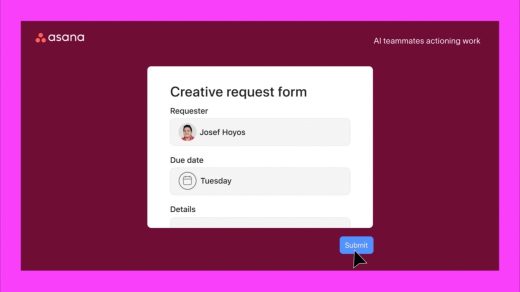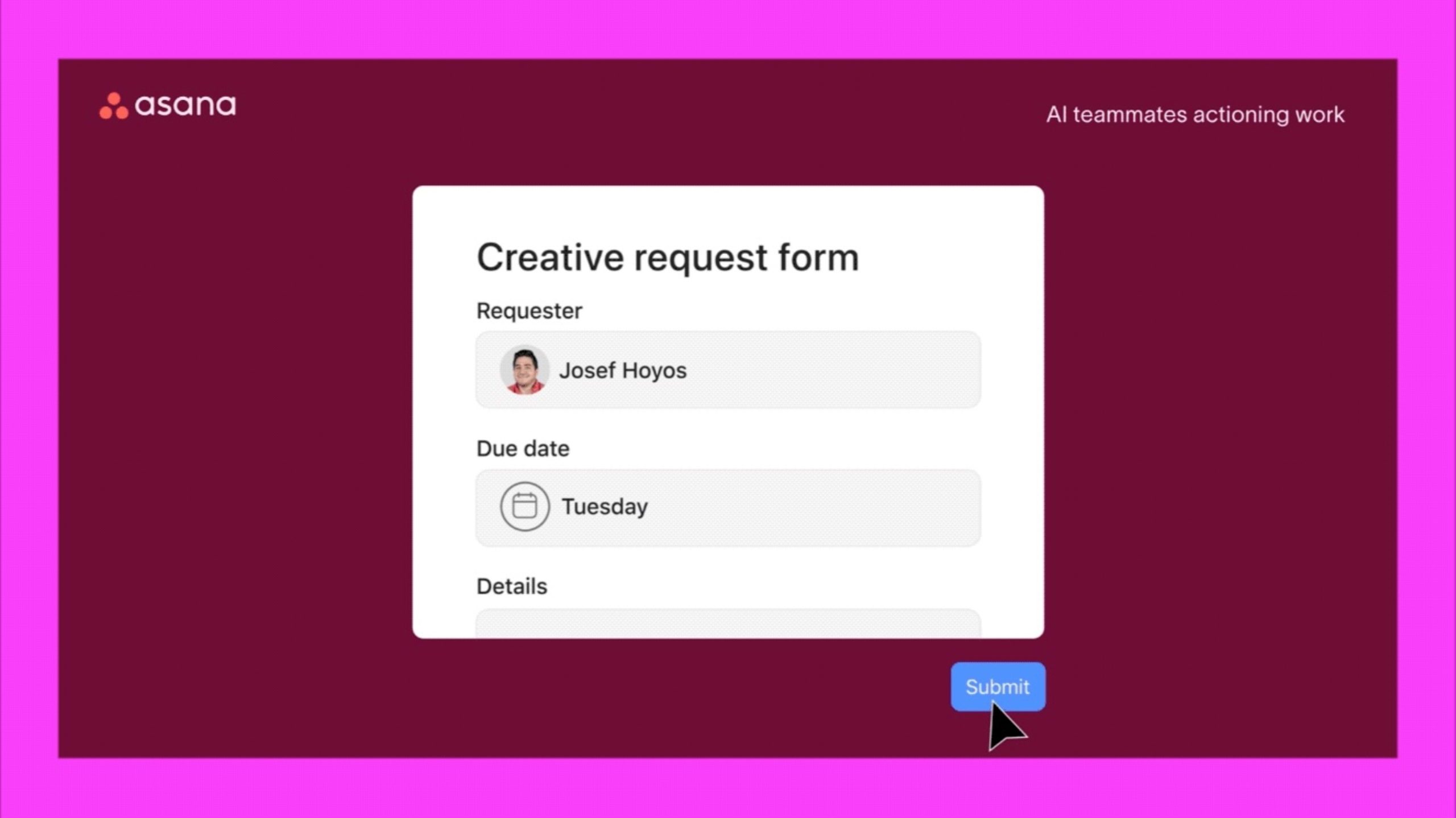Asana says its new AI teammates are ready to manage your projects
Asana says its new AI teammates are ready to manage your projects
The work management platform’s latest AI dives into the nitty-gritty of getting stuff done—sometimes with ‘superhuman’ results, says CEO Dustin Moskovitz.
When the tech industry describes AI’s role in its products, it hardly chooses language at random. Terms such as assistant and copilot reinforce that the human user remains firmly in charge—a comforting notion for anyone stressed over AI’s loose-cannon tendencies or even the prospect of it eventually rendering humans less essential to business processes.
And then there’s the name that project-management kingpin Asana picked for its latest wave of AI-infused functionality: “AI teammates.”
Calling a piece of software a teammate feels like a promotion, as if it’s earned the right to be considered a peer rather than an underling. (If nothing else, it has a strikingly different vibe than the more mechanistic moniker Asana was originally planning to use: “workbots.”) When I asked Asana cofounder and CEO Dustin Moskovitz about positioning AI as a team member, he emphasized the proactive nature of the new features—especially compared to chatbot-style AI that sits in a window of its own and doesn’t spring into action until called upon.
“It’s less about thinking of it as this separate thing on the side and more something that is in the workflow, as if it was another human,” he told me. “In many cases, I do think the outputs are as good as humans. Sometimes they’re superhuman.“
It will be some time before most of Asana’s 150,000 customers can judge the quality of the AI teammates’ handiwork. Currently being beta-tested by select customers, with general availability planned for later this year and pricing TBA, they’re debuting today at Asana’s Work Innovation Summit conference in San Francisco, seven months after the company’s first big wave of generative AI announcements, which included features such as a tone checker.
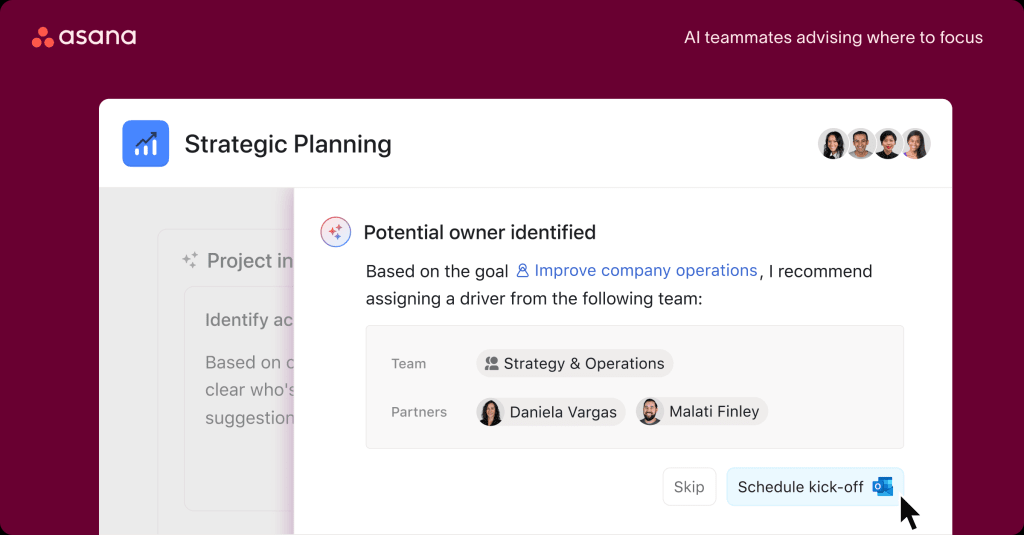
To be sure, nothing about the teammates involves AI operating in a wholly unsupervised fashion, let alone wresting control of jobs from people. But even when facilitated by software, project management involves countless tasks that are time-consuming but not all that mentally stimulating in themselves. There are responsibilities to be doled out, deadlines to be specified, and tiny questions to be answered, all in the service of a more substantive overarching goal. AI teammates are designed to bear some of that brunt in a manner that’s more anticipatory and detail-oriented than most existing work-centric generative AI.
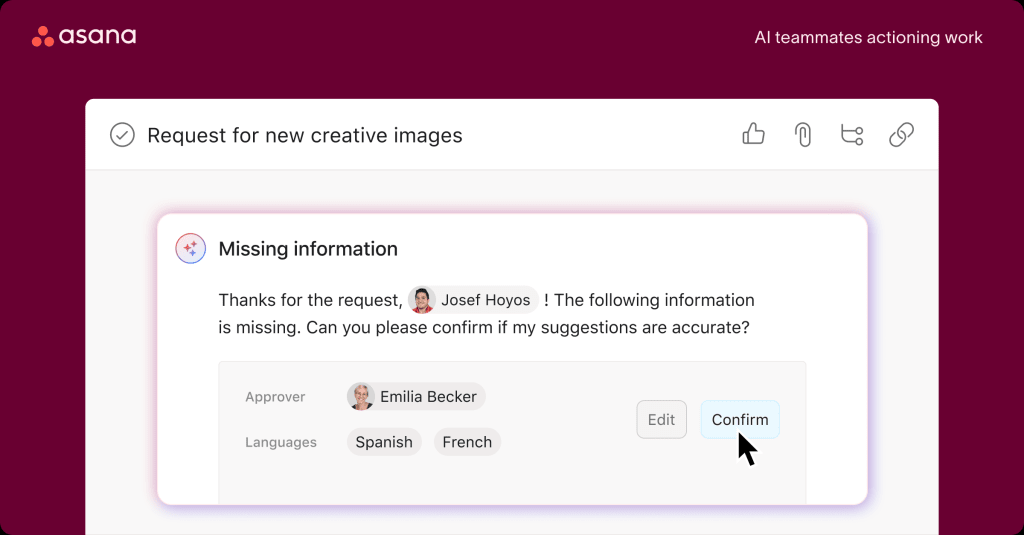
In a demonstration, Asana Head of AI Paige Costello showed me an AI teammate triaging a ticketed request asking a brand team to come up with some creative assets. As wrangled entirely by humans, such processes can involve a fair amount of back-and-forth before it’s entirely clear what’s being sought and how to fulfill it. Using Asana’s Work Graph—the platform’s understanding of an organization’s people, projects, and data and how they all relate—the AI teammate determined the steps required to get the project rolling, including confirming details, creating subtasks, and adding stakeholders. Then it performed them much as a human would.
The result—at least in the demo—was a project that was quickly poised for progress rather than at risk of slipping into temporary limbo. “Instead of this ending up assigned to the person who two days later realizes they don’t have what they need, it immediately is nudged back to the requester saying, ‘Hey, you’ve got to add more information if you want this to be acted on,’” Costello explains.
Asana formally launched a dozen years ago, long before AI was ready to enable this sort of automation. From the start, however, the platform was not just about working more efficiently but also achieving better results. For all the major decisions AI still isn’t prepared to tackle, Moskovitz argues, it can already take care of aspects that mere mortals tend to gloss over.
“Not only are you saving time, but you’re improving the quality and cohesion of all the work you’re doing,” he says. “Asana can not only make your process more rigorous so you’re doing all the steps, but it can add a lot of work that maybe you would do in a sort of cursory way if you were moving fast. You’d miss some things.”
Only so human
If you were to classify AI teammates using existing terminology, you’d probably call them agents. Indeed, that’s what Moskovitz did repeatedly when we discussed them. The basic notion of software agents that perform tasks for humans in semi-independent ways is far from new; here’s a 1998 article asserting they’d be one of the 21st century’s first big tech trends. Twenty-six years later, the requisite AI might be here, but agents remain an intriguing, somewhat futuristic concept rather than a workaday reality.
And so creating AI teammates involved more blank-slate decisions than if Asana were building a chatbot. (Although it’s done that, too: Starting later this month, paying customers will get access to a bot capable of fielding questions such as “What blockers are putting this goal at risk?”) The company had to determine whether its agents were better off as eager-to-please, emoji-lovin’ pals or anodyne automatons. It also had to weave them into an experience that people are already familiar with and don’t necessarily want to radically change all at once.
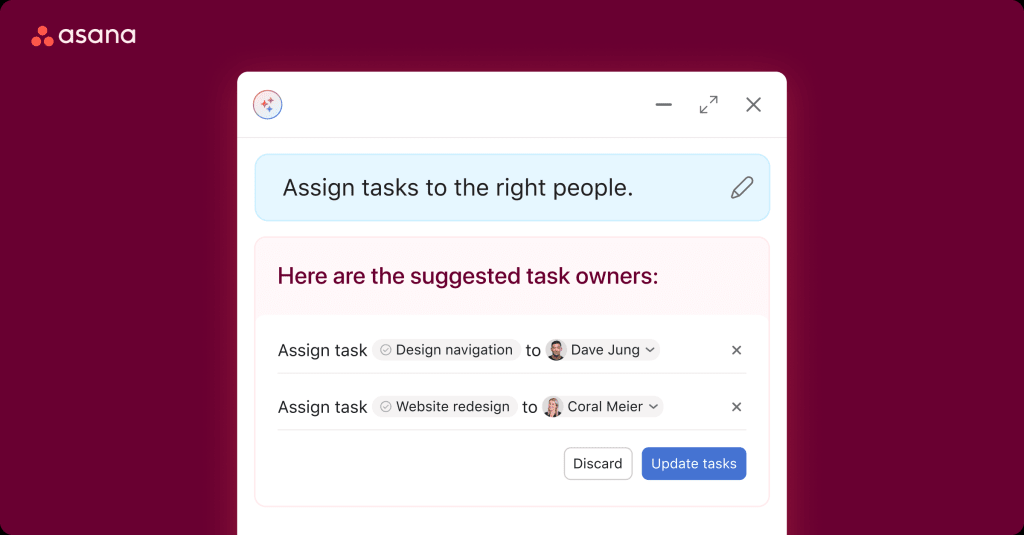
After wrestling with these sorts of issues, Asana came up with AI teammates that refer to themselves as “I” and address users by name. Still, the demo I saw was brisk and businesslike, without an in-your-face human persona: “We didn’t name [them] Devin or Alice,” Costello says. Even the basic fact that they aren’t chatbots makes them feel less, well, chatty.
Costello stresses that the way AI teammates work—performing useful tasks within Asana’s established framework of features—turned out to be even more powerful than the company expected. “We were able to capitalize on the reality that the mental model, when people work with AI as if it’s a teammate instead of as a tool, is that they ask better questions, get better results, invent better uses for it,” she says.
When I spoke with Moskovitz, the tech news cycle was still awash in coverage of OpenAI’s new voice mode, which—regardless of whether it sounds like Scarlett Johansson—unquestionably aims to create an uncannily human experience akin to the software Johansson voiced in the movie Her. That prompted me to ask him whether Asana’s AI teammates could eventually gain a naturalistic voice interface, further leveling the playing field between them and their flesh-and-blood counterparts.
He responded that adding speech would be doable—“It’s not that hard for us to just pass those audio files to [a large language model] and have it do its thing”—and might make sense at some point. But he added that the more complicated the task, the less it makes sense to interact with a computer by talking to it—and workplace collaboration is deeply intricate by its very nature.
“A lot of what the chat paradigm and the Her model give you is this idea [that] you’re going to give it something, and it’s going give you a result, and that’s the whole experience,” Moskovitz says. “And the result is either good or it isn’t. But when you’re working with a team on a project, it’s more complex. You’re going to take the first step, you’re going to look at the result, you’re going to add some feedback from your teammates, or maybe go through a legal review process. And it’s connected to other work, too. All of that stuff is poorly suited to a voice super-assistant model.”
Which isn’t to say that Moskovitz isn’t already looking forward to the day when features such as AI teammates will operate more independently, at least when wrangling certain aspects of work. “I think in the future, you will effectively assign subtasks to the agents, and they will complete them and give you the result,” he predicts.
Of course, the AI teammates’ destiny is inextricably tied to further advances in the large language models (LLMs) Asana uses. At the moment, it’s mostly building on top of Anthropic’s Claude and OpenAI’s GPT-4, but Moskovitz says tapping into multiple algorithms is increasingly easy. He expects Asana to end up leveraging major LLMs from companies such as Meta, Microsoft, and Mistral, along with other cutting-edge models as they emerge.
According to him, AI teammates already reflect not only improvements in the technology available to Asana but also the company’s growing competence at turning it into features that matter. “There are a few things that have happened,” he says. “One is that the models have gotten better, and so we’ve been able to use them for more sophisticated kinds of tasks and get higher-quality outputs. The other is that we’ve gained a better sense of what does and doesn’t work. That has been one of the most important realizations for me as a CEO. You really need to learn by doing—trying something in the interface and iterating. You learn ‘Yeah, the models aren’t really ready for this,’ or ‘Maybe they’ll be ready if we do a bunch of engineering work.’”
Everyone else bringing generative AI to the workplace is going through the same kind of education, and while the results have already had quite an impact, they remain a work in progress. A new survey conducted by Asana and Anthropic found that 54% of U.S. knowledge workers use generative AI at work at least weekly, up from 46% last July. Logically enough, those who use the technology the most are also the ones who say they get the most out of it, with 89% of daily users calling it a boon to their productivity. AI teammates seem to have as much potential as any generative-AI showcase I’ve seen in a piece of business software—but ultimately it’s human teammates who will decide whether they’re a high-value daily necessity.
You’ve been reading Plugged In, Fast Company’s weekly tech newsletter from me, global technology editor Harry McCracken. If a friend or colleague forwarded this edition to you—or if you’re reading it on FastCompany.com—you can check out previous issues and sign up to get it yourself every Wednesday morning. I love hearing from you: Ping me at hmccracken@fastcompany.com with your feedback and ideas for future newsletters.
ABOUT THE AUTHOR
Fast Company
(18)

